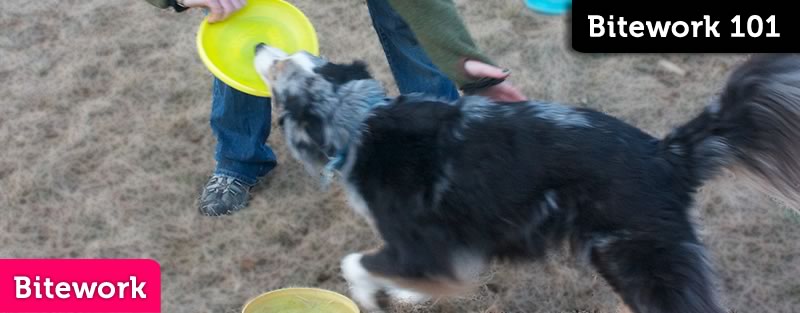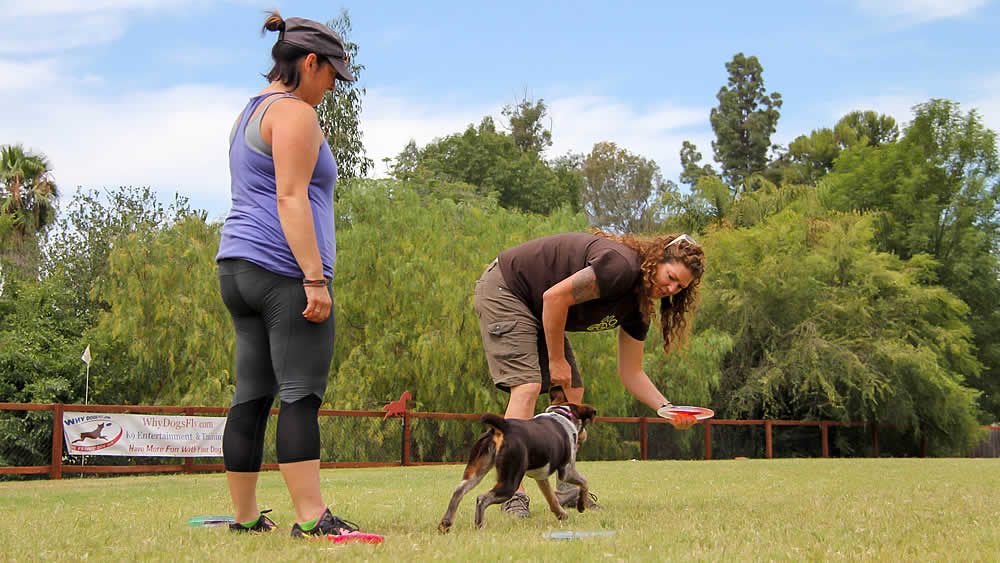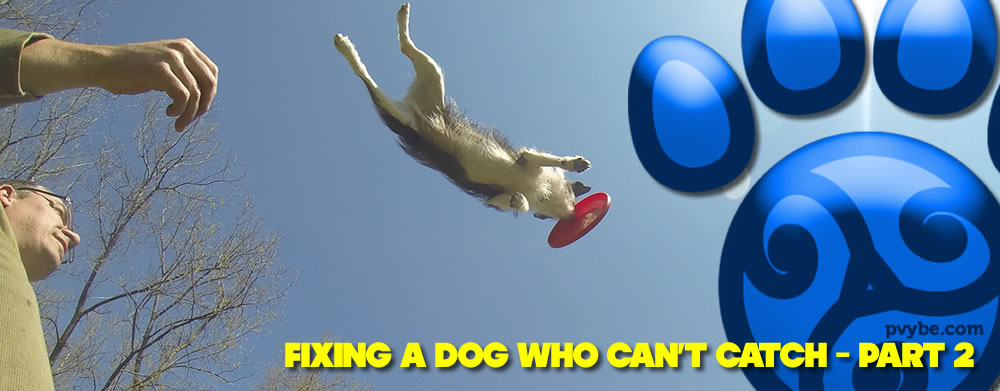
Fixing a Dog Who Can’t Catch – Part 2
this is the second installment in this series. Check out part 1.
continued from part 1 – yes, this is the same video but you should watch it again…
Roller
A Roller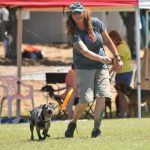 The Roller is a great throw for reinforcing a dog with a disc. Instead of flying through the air like a wing, the Roller rolls on the ground like a wheel; a fast,... More is a vital skill for disc dog training, and is simply a disc that rolls on end like a wagon wheel. The Roller simulates small game, like a bounding bunny rabbit or squirrel, triggering massive prey drive, and it maintains motion after a miss. I like to say Rollers are long on opportunity, as a well thrown Roller gives 3 and four chances for a catch, as you can see with Viper here.
The Roller is a great throw for reinforcing a dog with a disc. Instead of flying through the air like a wing, the Roller rolls on the ground like a wheel; a fast,... More is a vital skill for disc dog training, and is simply a disc that rolls on end like a wagon wheel. The Roller simulates small game, like a bounding bunny rabbit or squirrel, triggering massive prey drive, and it maintains motion after a miss. I like to say Rollers are long on opportunity, as a well thrown Roller gives 3 and four chances for a catch, as you can see with Viper here.
The long on opportunity and the nature of the Roller is tremendous leverage for teaching dogs to catch. Giving them multiple chances to make the grab and giving the handler multiple criteria to shape the catch of a moving object. Once you get a few catches under your belt, and you feel as if the dog is capable of making the catch, get off that bonking and recovery criteria and get to the clean catch. It’s important for shaping the catch of the disc in mid air.
The prey drive triggered by the likeness to small game of the Roller serves as both a powerful reinforcer and motivator for the catch. Having that roller right in front of your face, threatening to squirt away, makes the game more exciting and creates a burning desire and need to make the catch – motivation. It also makes the catch more likely to happen – it’s a reinforcer.
Bite
Reinforcing with a cued Bite on the target (bite and tug) is an important skill for building value on and around the handler and for creating and maintaining a high rate of reinforcement, generally speaking.
The criteria for the Bite is a bit counter intuitive. The teeth on part of the bite is not what you are looking for. If you mark and reinforce that, the dog immediately drops to either eat their cookie or to bite again. Using teeth on for your cued Bite criteria can and does create a simple clacking of teeth on the target, which is not at all a catch.
The criteria for a cued Bite is removing the object from the handler’s hand. I can’t really stress how critical this is to a good solid bite and the subsequent tug that everyone is looking for from their dog when doing bitework or reinforcing with a cued Bite or tug. This removal from the hand criteria helps the dog understand that maintaining control of the target is the object of the bite, this criteria reinforces proper bite technique and vigorous tugging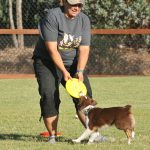 Bitework is an activity or a game that consists of biting and dropping a toy on cue. Cued Bites and cued Drops (and Gives) can be used to teach and reinforce many behaviors.... More and provides a great tool for shaping that Bite into a catch.
Bitework is an activity or a game that consists of biting and dropping a toy on cue. Cued Bites and cued Drops (and Gives) can be used to teach and reinforce many behaviors.... More and provides a great tool for shaping that Bite into a catch.
Use the Bite to complement the Roller. The Roller is a remote bite on a moving target, but it has an improper orientation for the flying disc. Using a cued Bite up to or around the waist is a great midpoint from the Roller to the Catch – putting some resistance on it as it happens is also highly reinforcing. Mix your cued Bites into the game to reinforce with energy levels, to complement the Roller and to shape the location of a catch, and prove that committing to and controlling the catch is the name of the game.
Rewarding with Action
Rewarding with Action is about creating opportunity out of working with the handler and/or next. We believe it is possible to reinforce the dog with the act of more work and it is possible to leverage the motivational aspects of some skills to reinforce a desired behavior. Rewarding with Action also allows you to efficiently transition from one skill to another and to sidestep many pitfalls of learning.
In the video with Viper, there was a lot of Rewarding with Action, and in a sense everything can be thought of as Rewarding with Action, after all, a disc being thrown is reinforcing with opportunity for Chase or the opportunity to Bite – there is nothing that guarantees that the work will pan out or that the ‘cookie’ will happen, and yet the dog is still highly reinforced by it. The dog doesn’t care about the cookie as much as they care about the opportunity for a cookie, and we can leverage that, as a matter of fact, the harder that cookie is to obtain in many cases, the more valuable it becomes.
So with Viper, I was reinforcing the catch with the Drop Cue, and reinforcing the compliance on the cued Drop with a Roller – another request for the target behavior, the catch. Do you see that? I’m reinforcing with my target behavior, the behavior that is weak and in need of being reinforced. That’s not quite right, the catch of the Roller is a target behavior, not a cookie, right?
Some positive trainers have real problems with this. “You can’t do that, it’s not a cookie!”, “But the dog doesn’t get the cookie… you’re going to ruin your marker…”, “That’s cheating.” there are all kinds of dogmatic arguments against it, but I think it’s sound in terms of learning theory.
Rewarding with Action is very closely related to reinforcing with Energy Levels and is the root of Next"Next" encapsulates the dog's anticipation of a forthcoming reward, sparking motivation and excitement. This expectancy creates a driving force that propels the dog through training, forming a continuous loop of engagement. When "Next"... More as CookieA Cookie is traditionally thought of as a food treat given as positive reinforcement. In that definition, a cookie is a discrete piece of food reinforcement. In many dog training discussions, the idea... More, so let’s hit on that and wrap this series up.
Next as Cookie
Next as Cookie is a huge deal for training in drive and dog training in general. Closely related to Reinforcing with Energy Levels and Rewarding with Action, Next as Cookie is the mechanical understanding that the Next thing and your dog does can, should, and often will be interpreted as a cookie. Unintentional use of this particular training concept is most likely what got Jaimie & Viper into this problem in the first place.
Knowing about Next as Cookie can go a long way towards diagnosing troubled behavior and can also be leveraged to clearly communicate when delivering cookies might be challenging or detrimental to learning the task at hand. In the video with Viper, Next as Cookie is clearly on display and was an important part of clearly communicating the intent of the game of disc.





